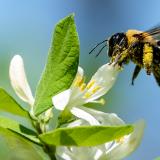The DTCF Partnership is filling the 18 planters with mostly native and local pollinator-friendly plants this summer, an initiative brought by the sustainability sub-committee. The goal is for each planter to serve as a small butterfly garden, a pollinator haven in an urban setting. Pollinators, which include butterflies, bees, moths, birds, and bats, have been in decline and are essential for the reproduction of both flowering plants and fruits and vegetables.
“We are building on the community’s pride in the City’s natural beauty, parks, and River,” Executive Director Abby Poeske said. “One of the DTCF Partnership’s goals is to celebrate its local heritage and maintain the historical look and feel of Downtown. The nature and native plants are part of this. We are so excited to help the local pollinators thrive, even in this hyper-local way. Our planters are like little rest stops for butterflies between our beautiful City parks. It is a small step on the way towards a greener Downtown.”
The native and/or pollinator-friendly plants include: purple coneflower, butterfly weed, bee balm, purple poppy mallow, and verbena. These are all perennial plants and at the end of the season, the DTCF Partnership intends to raffle off most of the plants (trees excluded) to the folks to plant in their own yards. More details on that will be announced at the end of August or early September.
In addition to sponsor plaques, there will be a few plaques with information about the native plants, pollinators, and why the DTCF Partnership chose these plants this season. These plaques can be found along Front Street in the planters between Broad Boulevard and Portage Trail.
What are native flowers? Native plants are suited for the soil and weather of a specific location. Pollinators depend on them for food. Non-native plants compete for space, sunlight, and other resources and spread very quickly, crowding out our native species. A native flowering species to Northeast Ohio you might see in this planter is the perennial purple coneflower (Echinacea purpurea).

What are some of the native flowers in these planters? The butterfly weed (Asclepias tuberosa) can be found native in NEO, is typically a bright orange, and is a cousin of milkweed (another native pollinator). It is a perennial that is great for local pollinators. This hardy flowering plant will be in bloom from May to September. You may also find purple coneflowers (Echinacea purpurea), bee balm (Monarda), and purple poppy mallow (Callirhoe involucrata) in the planters.

What are pollinators and why are they important? Pollinators are important because they are essential to growing flowers and even food that we can eat. Pollinators land on flowers to drink their nectar and pollen sticks to their bodies as they do so. When they move onto another flower, the pollen is dusted off of the pollinator's body as it consumes more nectar. This helps the plant reproduce. In NEO, some examples of pollinators are butterflies, bees, and hummingbirds. Bees are an endangered species pollinator but are key in products that we enjoy every day; they produce honey and help farmers to fertilize and grow their crops.

A special thanks to our Planter Sponsors this year: Portage Community Bank, C.K. Dream Team at RE/MAX Crossroads, Asterisk Coffee Bar, TRIAD, Cashmere Cricket, Commonwealth Properties, Boy Scout Troop 155, Ward 4 Councilwoman Mary Nichols-Rhodes, the Rice Family, the Poeske Family, and Bob and Lisa Goldstein.
